its paid sponsors, whose products you need!
| Home |
| Intro |
| Current Issue |
|
Mailing List |
| Store |
| Strength |
| Subscriber Content |
| ARCHIVES
|
| Martialism |
| Pacifism |
| Q & A |
| Cunning-Hammery |
| Advertise With Us |
| Submit An Article |
| Staff |
| Discussion Forum |
| Links |
“Stay ‘unreasonable.’ If you
don’t like the solutions [available to you], come up with your
own.”
Dan Webre
The Martialist does not
constitute legal advice. It is for ENTERTAINMENT
PURPOSES ONLY.
Copyright © 2003-2004 Phil Elmore, all rights
reserved.
Self Defense Gear M-Tech Kerambit
A Product Review by Phil Elmore
James and the staff at Self Defense Gear
can’t leave well enough alone. The owner of the official store of The
Martialist understands the concept of “value added” and works
hard to provide his customers with a variety of options.
The kerambit is the latest craze in
self-defense blades and martial arts implements. An Indonesian weapon
with a blade that curves inward like a small scythe, it is favored by such
notable instructors as Steve
Tarani and Ray
Dionaldo. Custom makers like Richard
Derespina specialize in them, while many manufacturers
offer production versions. Many of these blades are quite expensive, but
blade aficionados will generally tell you that they are well worth the cost.
There is a large segment of potential buyers,
however, who simply will not or cannot pay hundreds of dollars — or even as
much as fifty or sixty — for a knife, particularly if they aren’t sure the
kerambit is right for them. It was with this idea in mind that James
began offering the M-Tech kerambit. While Self Defense Gear offers a
variety of more expensive self-defense tools, it does not neglect less costly
products. James’ goal is, as he explained to me, to provide lower-end
merchandise that gives good value for the low cost paid.
M-TECH AND THE KERAMBIT
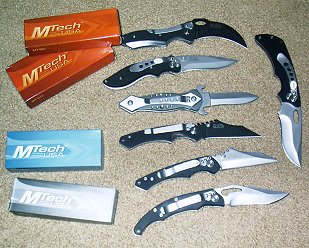 M-tech
M-tech
is an imported Chinese brand. Chinese imports are often synonymous with
“junk knives,” only a step above Pakistani “hand-made”
blades in quality. Most of the folding knives in the M-Tech product line
are, while not what I would consider junk, nothing remarkable in terms of such
imports.
I evaluated several of M-Tech’s liner
locks. The handle materials are heavy carbon fiber and generally very
solid, while the blades demonstrate a greater attention to detail than I expect
from cheap Chinese imports. Several of the knives, however, had liners
that engaged all the way to the right, almost past the blade tang, which
allows no room for wear and may not even provide safe lock-up at all.
Several of the designs in the line also seem somewhat bizarre — solutions to
non-problems in search of a market.
The M-Tech kerambit, on the other hand, is
easily the best of what I’ve seen of the M-Tech line, by a considerable
margin. While it isn’t perfect, it has a certain amount of
potential. For those who wish to explore the kerambit concept but who
don’t want to risk a lot of money on it, it’s a viable (and extremely
budget-friendly) option.
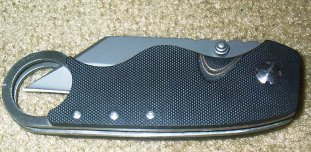
At 6.2 ounces and a folded length of 4.5
inches, the M-Tech kerambit is very chunky. Without the pocket clip, it
is a full half-inch thick through the handle scales. The scales themselves
provide a fairly good grip and have nice bevels for the ambidextrous opening
studs. The thick metal liners extend beyond the handle scales to form
the finger ring, though the rings aren’t connected and don’t feel very
solid. (They can be squeezed together to the point that the liner lock
itself shifts against the blade tang.)
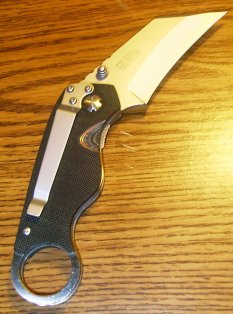
The blade steel is only 440 series. It
has a pleasant brushed appearance, but I did not expect it to hold an edge for
long when I started using my test knife for utility shores.
Surprisingly, the three-inch honed portion of the blade held up better than I
expected (though that’s not saying much). It was also incredibly sharp
out of the box, the curved edge proving perfect for opening the numerous
packages and pieces of mail I process every day.
The pocket clip, while it has three mounting
points, has some side-to-side play. I tried tightening it but could not
eliminate the problem. The knife is set up for “tip-down”
carry only. This means the knife cannot be indexed properly and drawn
from the pocket using the finger hole — but of course, the finger hole is
full of sharp blade when the knife is closed, making this impossible
anyway. (That will be the single biggest complaint kerambit users have
regarding M-Tech’s design.)
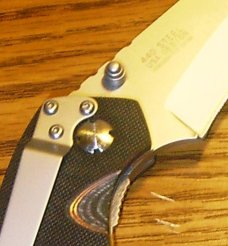
The liner lock was a pleasant surprise,
however. It snaps firmly in place in the center of the blade tang.
The tang itself has a pronounced angle to allow for some lock wear.
Experienced knife collectors will be able to tell, just from the appearance of
the blade steel and the liner, that this wear will occur more quickly than
with higher-end knives — but again, this is a “budget piece.”
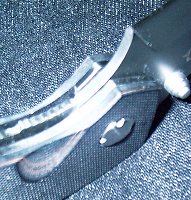
ENTER SDG’S VALUE-ADDED
I spoke with James at SDG and he confirmed my
suspicions. Specifically, he can’t leave well enough alone where
the M-Tech kerambit is concerned. Previously, he altered standard metal
pocket sticks to produce more versatile “Koppo-tons,”
which he sells through the site. It was with the same “make it
better and make it work” attitude that James turned his attention to this
little knife.
“From the start,” James told me,
“I was intrigued by Liong Mah’s kerambit design. Like
everybody else I eagerly awaited its release. When I finally got them I
realized that there were a few design flaws. I know, you’re asking yourself, ‘Did he say flaws?’
Well, yes. Keep in mind,
as far as folding tactical knives go, this is a fine tool for the low price —
but it fails to
perform well in the task for which it was specifically designed.
“The first issue I addressed was clip orientation. For a design like this to
work you have to be able to draw it in reverse grip. I accordingly reversed
the direction of the pocket clip.”
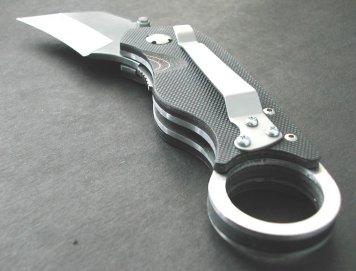
Pocket clip reverse on SDG-modified kerambit.
Photo by SelfDefenseGear.com.
“Blade length was the next issue,”
James explained. “The finger ring was useless for drawing the
knife because the closed blade protruded into the ring. To remedy this I cut
the blade down from 3 inches of cutting edge to 2.125 inches of cutting edge.
This not only allows drawing and presentation from the pocket in one motion
but results in a weapon that moves faster thanks to the reduced weight. I removed the
bead blast finish on the blade and polished it to a medium matte finish.”
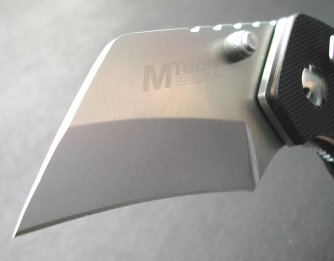
Reground blade on SDG-modified kerambit.
Photo by SelfDefenseGear.com.
Making modifications on this scale is not
without its hazards, as James well admits. “On the first prototype
I made, the blade was double-edged on the last half inch. Everyone to
whom I showed it in the first week cut themselves. This would have to be
an option and not a standard feature.”
I’ve already mentioned the flexibility of the
liners that form the dual finger rings. James noticed this too, and
disliked it as much as I did. “The third modification I made,”
he said, “Was to fill in the gap between the
finger rings, which was no longer necessary with the shortened blade. I machined a polymer ring and epoxied it in place on one of the
steel bolsters. This gives the knife a much firmer feel and a more finished
appearance.”
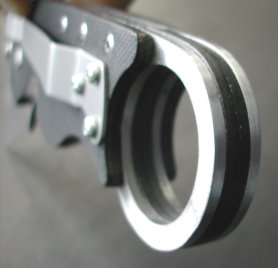
Polymer-reinforced ring on SDG-modified
kerambit. Photo by SelfDefenseGear.com.
The clip play issue was one I found
particularly bothersome, so I made sure to ask James about that.
“Yes,” he confirmed, “I was able to address the clip
play. I did this by 1) going to larger hardware; 2) drilling through
both the G-10 slab and the steel bolster beneath it; and 3) nuting the clip
screws from behind the bolster. This arrangement is much stronger than
tapping the holes for the screw threads.”
James sent me one of his modified prototypes
and the results were every bit as good as he described them. The pocket
clip was firmly secured and trimmed to make the end protrude less
awkwardly from the body of the knife. The polymer reinforcement made the
ring feel great and provided a tactile reference for spinning the little
knife. Spin it did, too, the shortened blade snapping out much more
quickly and the whole knife moving much faster than the original.
While the original M-Tech kerambit could not be
deployed quickly at all, the modified version can be drawn rapidly with the
index finger and wrist-snapped open in a proper reverse grip. The handle
is still a little chunky, but the knife is 100% improved. It’s almost a
completely different tool.
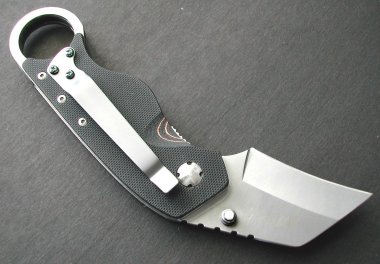
SDG-modified kerambit.
At “press time,” the SDG-modified
kerambits were not yet ready for sale, but James was working industriously to
add this maximized implement to SDG’s growing catalog of tools and
weapons. The factory M-Tech kerambits are available now.
I suspect this is only a
fraction of what he is capable — making SelfDefenseGear.com
a store and site to watch in the future.
